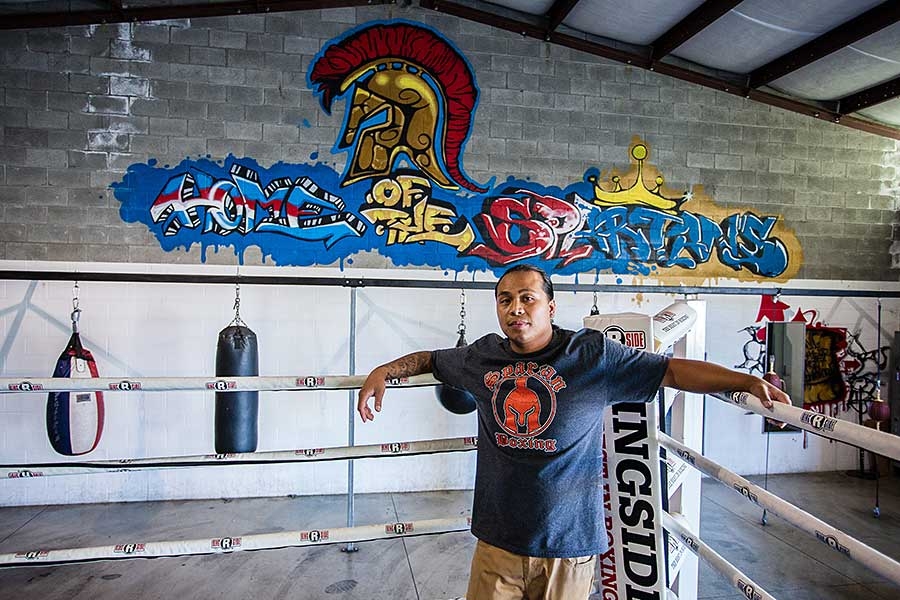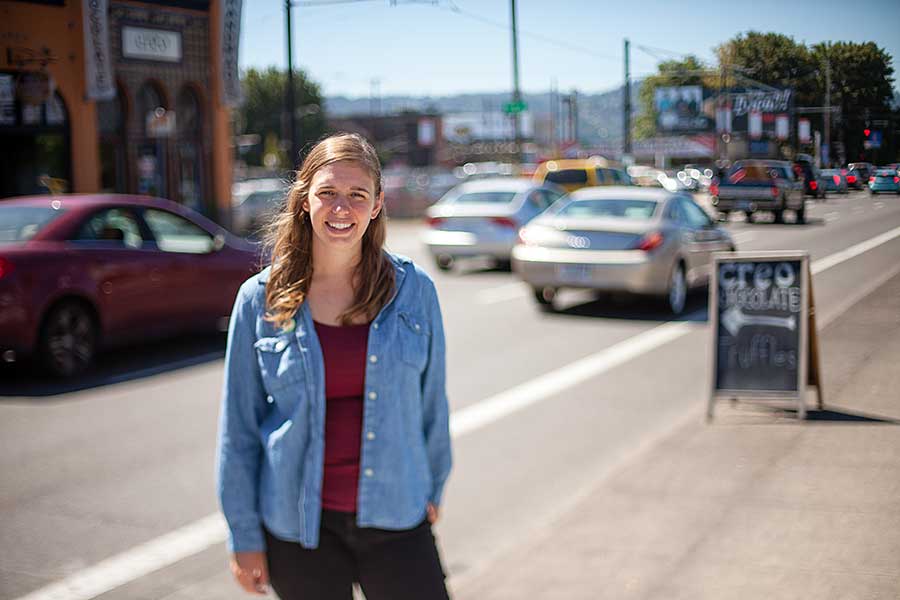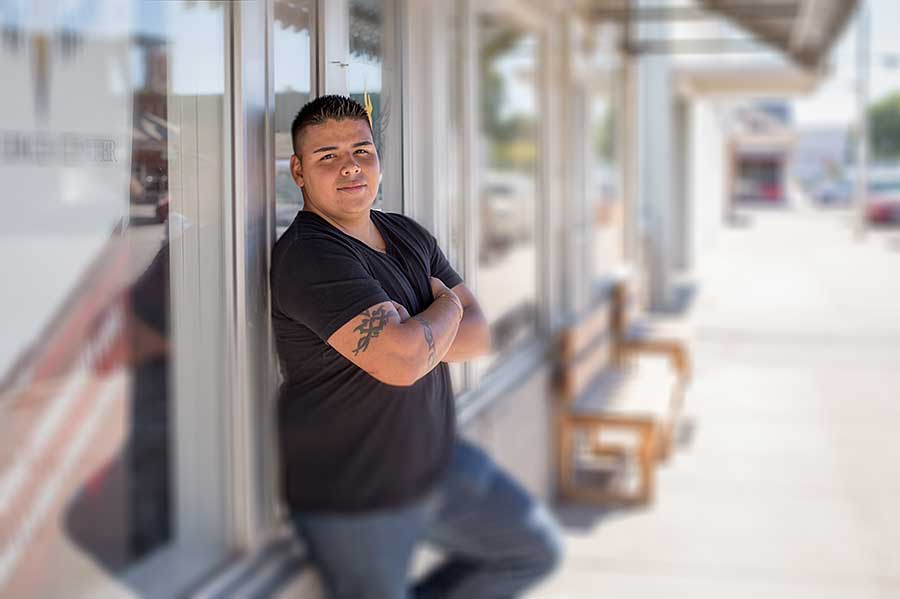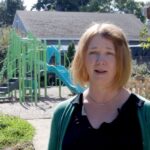Profiles of four rising stars.
Fighting Spirit
Troy Wohosky, president/head coach
Spartan Boxing Gym
Medford
When 7-year-old Troy Wohosky moved to Oregon from the tropical Philippines, he saw his breath for the first time. But it was what he didn’t see in his new Medford home that affected him more. “There were not a lot of other Filipinos,” he says, recalling how the move fueled an already burning anger. He got into street fights, dropped out of school, joined a gang at 13 and became a father two years later.
Boxing turned Wohosky’s life around. When his gym closed in 2007, he started training in his driveway with donated equipment. Neighborhood kids saw him working out and clambered to join in. When Wohosky missed qualifying for the 2008 Olympics, he realized his vocation. “I wanted to open a gym and work with youths,” says the now 30-year-old.
He opened Spartan Boxing Gym in a 5,000-square-foot empty building in Medford in 2012. The first year’s rent was free, donated by a father of one of his students. The 501(c)(3) nonprofit license came one year later, paid for with the purse Wohosky won boxing at Seven Feathers Casino.
Today Spartan Boxing serves a diverse group of youths and adults. There is a monthly fee to train at the nonprofit, but Wohosky offers scholarships and outreach to at-risk youth. A big part of that outreach involves transporting kids, often spread throughout rural Jackson County, to and from the gym. “I give the kids bikes or organize rides,” he says.
In the four years since starting Spartan Boxing, Wohosky has served about 300 at-risk youth, some as young as 4. At first, only about 20% to 30% were passing their classes. Today that number is 75%. Wohosky estimates that 20% of adult gym members and 60% of youth have dropped their gang affi liations.
Funding comes from various sources: the Robert and Frances Chaney Family Foundation, the West Family Foundation and the K.E.Y. Gang Project through the Oregon Youth Development Council.
Spartan Boxing faces challenges familiar to all nonprofits: the need for more money, more space and more volunteers. These hurdles are compounded by funders reluctant to donate to a boxing gym. “People always ask, ‘Why boxing?’ says Wohosky, explaining that the sport is good for kids who are angry, depressed or suicidal. “It’s a lifestyle, not a sport. You play basketball but you don’t play boxing.”
Home Front
Brandi Tuck, executive director
Portland Homeless Family Solution
Portland
As Portland’s homeless situation reaches emergency proportions, ideas about how to address it continue to churn. From mayor Charlie Hales’s “Safe Sleep Guidelines” to developer Homer Williams’s plans to turn Terminal 1 into temporary shelters, it’s clear that government and business are searching for answers. Brandi Tuck, executive director of Portland Homeless Family Solutions, knows that public camping and temporary shelters are not a real solution to homelessness.
“We have a growing population and not enough housing,” says the 33-year old, who started volunteering at PHFS in 2005 before becoming executive director two years later. The situation, she explains, creates a domino effect where rising rents force working families into worse apartments, and families in those apartments are forced onto the streets. “Everyone moves down.”
Tuck remains hopeful about Portland’s affordable-housing bond measure on the ballot this November, which promises to fund upwards of 1,000 units. The Terminal 1 project, however, leaves her skeptical. “That will only be successful if there are nearby resources and services,” she says. “You don’t want to warehouse people where there is no hope of changing the situation.”
Perhaps Terminal 1 could take a page from Tuck and PHFS. The organization moves between 150 to 200 homeless families into permanent housing each year, providing shelter, services and counseling every step of the way. Most are still in their homes one year later.
While she admits that there will always be some episodic cases, Tuck believes that more affordable housing will solve chronic homelessness. “We’re fighting a lot of mixed perceptions,” she says of a public that brands the homeless as drug addicted, mentally ill or lazy. “Two-thirds to three-fourths of parents in homeless families are working full time.”
Tuck’s passion for the cause surprises even her. She studied organizational leadership for nonprofits at the University of Florida and chose a spring-break community service project in homelessness and poverty on a whim. The experience “changed my life. I came back to school recharged and refocused,” she says.
Today hiking and yoga keep the young executive from burning out. She also credits PHFS’s board for investing in their 24 employees. Entry-level staff make $15 an hour, and everyone gets health care, dental and paid parental leave. “We have an amazing community here, and I can still step out and have a life.”
Walk the Talk
Noel Mickelberry, executive director
Oregon Walks
Portland
Looking for stories of classic, quirky Portland activism? Oregon Walks’ early history delivers. From founding members “bopping” unyielding autos with diaper bags to protestors “driving” cardboard cars on the downtown transit mall’s sidewalks to protest parking rule changes, the grassroots group comes across as kind of goofy.
It isn’t.
Since its formation in 1991, the nonprofit, formally known as the Willamette Pedestrian Coalition, has elevated lowly walking to an integral part of the region’s multimodal transportation system. The group has changed as well. “We’re still scrappy,” explains executive director Noel Mickelberry, “but we’re more policy based. We’ve figured out how to change the conversation.”
Executive director since 2014, 29-year-old Mickelberry is excited by Oregon Walks’ potential and a city government that’s interested and invested in walking. Still she remains cognizant of challenges, particularly in making sure that improvements are distributed equitably. “There are still serious disparities in the region,” she says, referencing poorer areas with no sidewalks and traffic moving at 35 to 40 mph. As a result, racial and ethnic minorities are more likely to suffer pedestrian fatalities.
In response, the organization has partnered with the Bicycle Transportation Alliance to propose Portland adopt Vision Zero. This worldwide effort strives to eliminate all traffic-related fatalities by 2025. Mickelberry admits that reaching such a lofty goal is perhaps impossible.
The group is also working on more incremental changes to raise walking awareness. This year will see the first Oregon Walkways (think Sunday Parkways but for pedestrians instead of cyclists) in Portland’s Cully neighborhood. It also partners with Portland Public Schools, identifying barriers that keep students from walking to Title I schools. Their reach extends into the suburbs, enforcing land-use policies in Washington County and beyond to Astoria, Springfield and Roseburg.
The biggest challenge Mickelberry and Oregon Walks face is the broadness of the issue. In response, she is sharpening the organization’s message, shaping advocacy and wonky policy work into a compelling narrative to tell funders. “We all walk,” she says of the decidedly unsexy activity.
A Voice for the Voiceless
Gustavo Morales, executive director
EUVALCREE
Ontario
Latinos and non-latinos live side by side in Malheur county, but the relationship is less than neighborly. “Th ere have been leaders who openly commented that we [Latinos] are responsible for all of the area’s problems,” reports Gustavo Morales, executive director of EUVALCREE, the Eastern Oregon Latino Alliance for Children and Families. That anger is met with frustration and defeatism, and the result is a volatile, potentially dangerous atmosphere.
Morales hopes EUVALCREE will change perceptions. A composite of three Latin words (EU is good, VAL is strong, CREE is belief), the 180-member group works to develop social capital and leadership capacity in the community. “Our primary goal is to improve our community’s standard of living and quality of life,” says Morales, “along with overcoming stereotypes and biases.”
Morales was starting his third year of medical school when he stopped to get an MBA in preparation for setting up his own practice. At the same time EUVALCREE was getting off the ground. A lifelong participant in nonprofi ts, Morales jumped onboard, fi rst as a volunteer executive director in 2015 and then as a paid one a year later.
While Morales draws a salary as a contractor, the 24-year-old is skeptical about business’s power to change the world. “When you involve money, integrity goes out the window,” he says. “It becomes about maintaining the institution.”
In his short time as executive director, Morales has enjoyed some successes. He lists a well-attended Latino leadership program and a Children’s Day event that brought 1,500 community members together, including city and county officials. He’s presently working on distilling information from a 500-person community assessment to define strategies and create an action plan.
One thing he doesn’t want to do is duplicate services. One hundred thirty nonprofits already operate in Ontario, but many admit that they haven’t done a good job of meeting needs, according to Morales. He hopes to change that.
He also hopes that EUVALCREE’s work will create a more positive atmosphere. “If you bring a fist to a conversation, all you get is another fist. It’s not effective or efficient and it goes against the idea of empowerment.”









